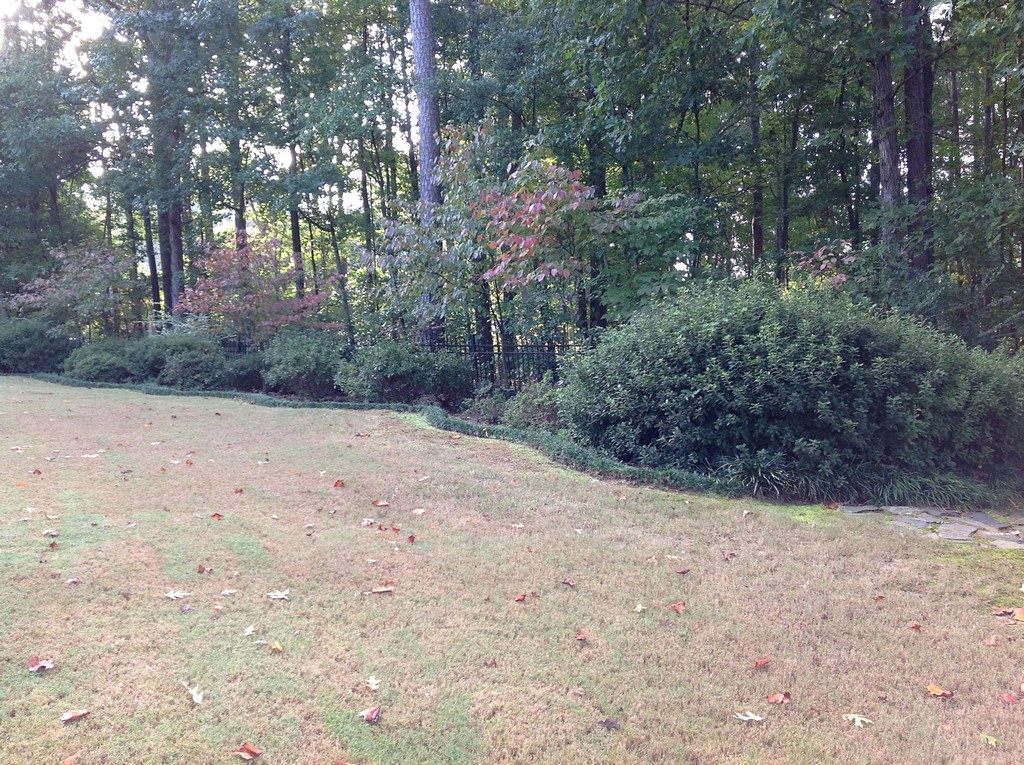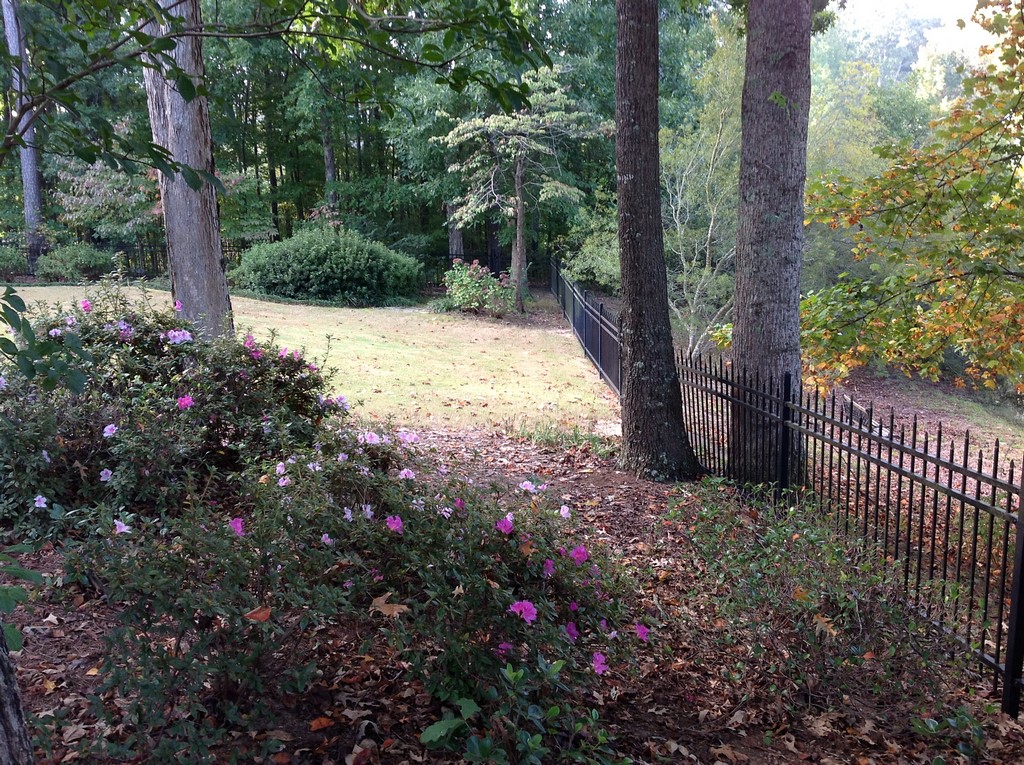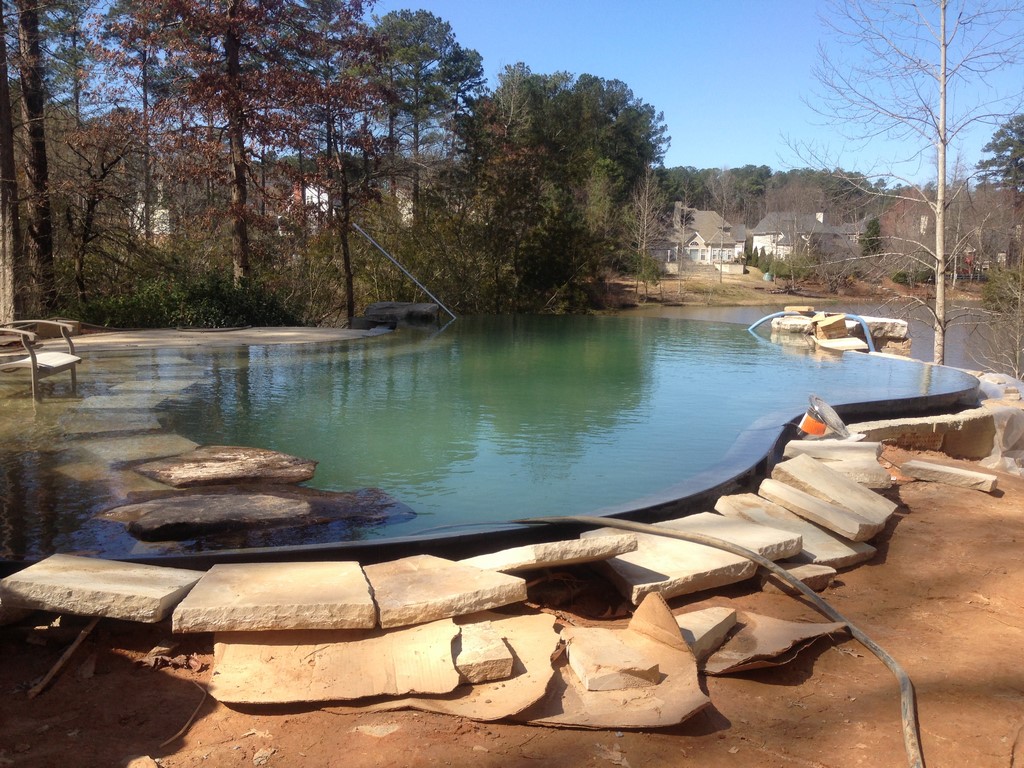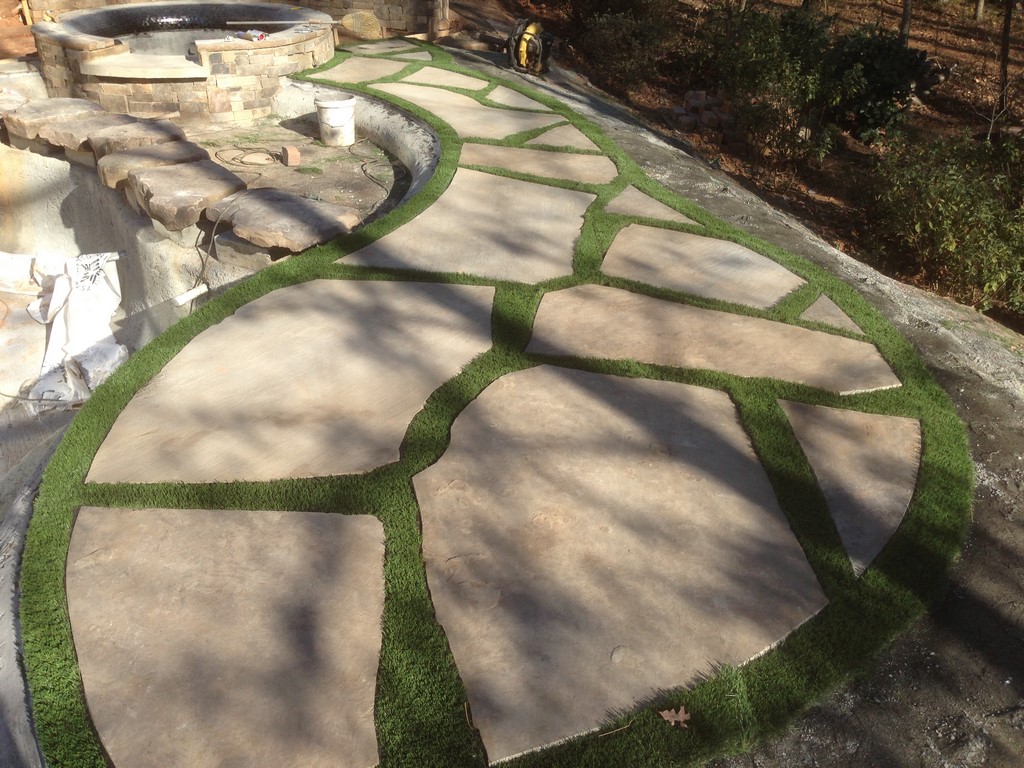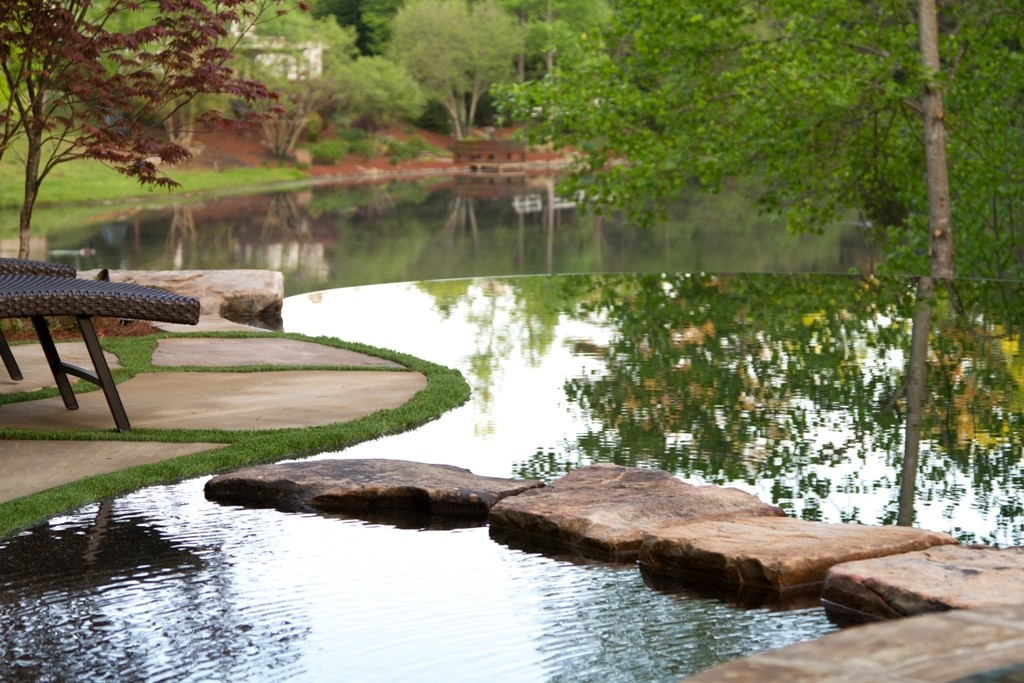The Perfect Perch
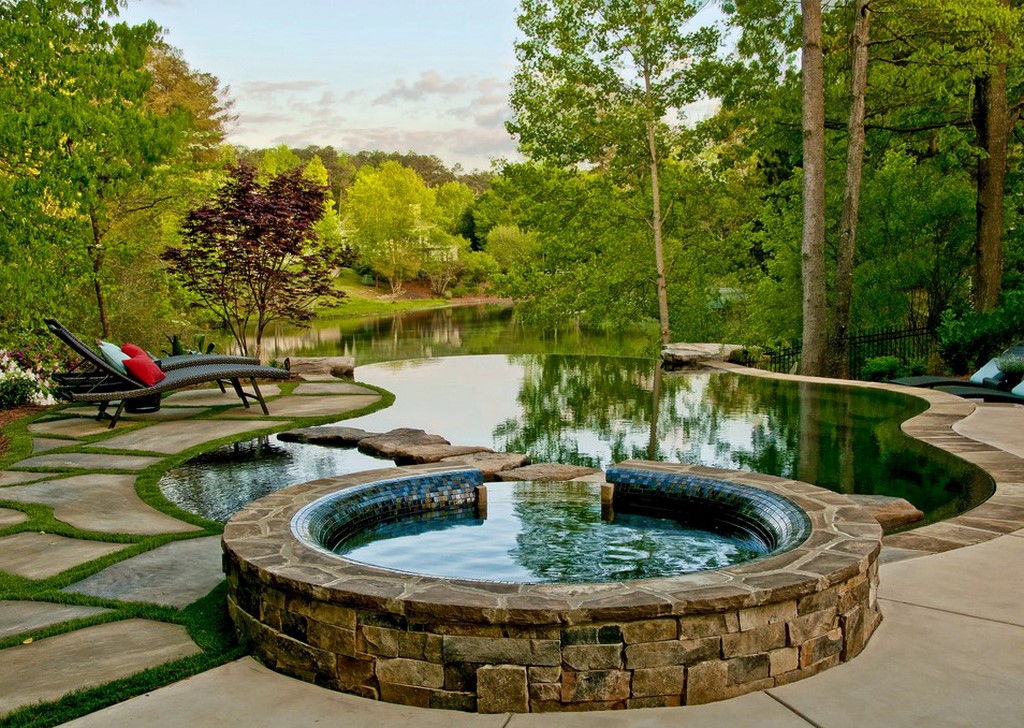
We may have wrapped up the project discussed here more than five years ago, but I still see this backyard almost every time I take clients around to see examples of our work. The way I figure it, there’s no better way to start a portfolio tour than by knocking prospects’ socks off.
There’s lots of cool stuff going on here, some of which can readily be seen: the sweeping, Lautner-style perimeter-overflow edge around much of the free-form pool; the glorious water-on-water vanishing edge overlooking a large pond; a nice, full-featured spa; and the floating steps that lead across the pool to a prime seating area.
Then there are things that can’t be seen unless you take a good look, including the full-perimeter bench inside the pool, the rolled interior walls for comfortable sitting and some carefully placedreturn outlets that make the water passing between the floating steps seem as though it’s a river’s current. And completely out of sight is a substantial (and much-needed) dewatering system.
As important, this project included a colorful client, a fantastic setting and multiple opportunities for me to put unusual ideas into play. So there are good reasons for me to keep coming back – and yes, lots of them have to do with the fact that the backyard is truly gorgeous.
ONE BY ONE
The property is located on a cul de sac in Peachtree City, Ga. Our work on that particular street had started a couple years before at one corner where we built a pool, then moved to the next lot and then the next. The project under discussion here is on the fourth lot, and not long afterward we built a pool for the fifth and final home in the chain. To say we know the neighborhood is an understatement.
Despite all that experience, the client who called me in about the fourth lot was convinced nothing could be done: He disliked the retention pond’s plain, utilitarian appearance and its inconsistent water level. He also lacked affection for the slope down to the water’s edge. His basic conclusion, he told me, was that he wanted something that would build up the yard and entirely block the pond from view!
Despite his ultra-low expectations, he called me because I’d done nice things locally and he figured it was worth a conversation. And deep down, he told me, he really wanted a pool and spa. No problem, I said: I’d seen hopeless lots and his wasn’t one of them. What I saw instead was boundless potential and knew my biggest challenge was going to be convincing him that anything beautiful was possible.
The story is, he’s a talented graphic designer who, on his own, just couldn’t visualize positive outcomes in his backyard. So I drew up a hand-colored rendering and presented it to him to an immediate, positive reception: All of a sudden, he was fully engaged – still fuzzy on the details but convinced it would be pretty and anxious to get going.
| The backyard as we found it was open, relatively featureless and definitely had a slope to it. Even so, it was tough to understand why the homeowner was so pessimistic about its potential, particularly given the pond as a backdrop. As it turned out, all we had to do was present him with a full-color, full-featured rendering of his new poolscape: He came around in a hurry and was particularly pleased we planned on retaining almost all of the trees and plants he’d put in place. |
I come at pool design with a landscaping background, so I worked with the bones of the overall space – and particularly with the plantings he’d placed throughout the yard. Basically, he’d done well enough that my design radiated out to meet up with what was already there, with the poolscape taking on a free-form, naturalistic shape and providing a set of sweeping, undulating lines to guide the eye out to the water-on-water view.
I know from experience, of course, that working in natural forms is often a lot harder than it is to work with linear forms. And that’s when the Lautner edge popped into my mind: I wanted to use one here to prove to myself it could be done (and done well) on a curvilinear pool. I also wanted to make it happen with a compact, 12-inch bond beam with water flowing up a rolled wall section into a narrow, deck-level slot – the reverse of the usual approach. In addition, I wanted to place a bench around the entire interior perimeter of the pool (except for the section fronting the vanishing edge) and wanted a portion of the Lautner edge to flow toward an artificial-turf detail that, five years ago, I’d never seen before.
Even the floating-rock steps across the pool were part of my exploration of new ideas: As he crossed the water, I wanted the client to be able to look down and see a strong “current” running between the stone pedestals – enough to simulate the sound and sight of water flowing through boulders on a natural stream.
The project’s possibilities and the client’s love of beauty made me feel ambitious, in other words, and we at Selective Designs (Atlanta) were off to the races to make it all work – despite the fact I wouldn’t actually be charging him for much of the experimentation.
DISTINCTIVE DETAILS
All of these details were rattling around my mind before we started digging, at which point a sharp tug of reality pulled me back from my creative deliberations.
Access to the site wasn’t all that easy – mainly via a cart path that ran around the edge of the retention pond. When we started the excavation, the first thing we recognized was that we would be digging quite a bit deeper than we’d anticipated: The soil was a muddy, saturated mess, so we had to overdig to set up an extensive dewatering system that would require a good layer of drainage rock and piping before we could start working on our shell.
| The curvaceous, comfortably rolled pool walls lend an easy, natural touch to the pool, and we used the same approach in the spa, which the homeowner now uses almost every day. But the fact is, producing a curving Lautner-style, perimeter-overflow approach takes a lot of work – and even more so in this case, because we were experimenting with an artificial-grass edge for an important part of the perimeter. |
The drainage system operates a good bit of the time – especially when the weather gets wet and the pond rises above its typical level. By the time we backfilled, we were confident we could keep ahead of any infiltration, but we were dealing with a lot of water and saw a need for managing it constantly down the line.
By this time, we’d made a key decision about positioning the pool in the available space: Given the fact that the operating level of the retention pond ran high in rainy periods and drew down quite a bit in the dry season, we moved the watershape out from the house and set its level in such a way that we pushed the perspective from the deck well out toward the pond’s deepest area: It wouldn’t do, we thought, to risk having the water-on-water view become too elusive!
|
A Decking Debacle We knew we wanted to seal the rockwork around the pool, so we brought in samples and asked the client about his preferences. Quite quickly, we settled on the neutral appearance of a penetrating sealer, and that was that – or so we thought. There was a miscommunication, however, and the masonry crew came in and applied an oil-based material we’d rejected – a glossy, shell-like coating that made the stone look anything but natural. The client’s call came swiftly and understandably bordered on desperation. Needless to say, we had work to do. But the sealer had been so well applied that it was like stripping an old piece of painted furniture, bit by bit, until we reached the original material. Once we applied the correct finish, we were all set, a bit poorer but considerably wiser. — S.LeB. |
Once the dewatering system was in place and we had laid out the pool, we tackled the framing, steel reinforcement and plumbing and finally made ready to shoot the pool – an event with which I was intimately involved to make certain the jig I’d developed would be used to meet the specifications we’d set for the rolled walls and the Lautner edge. It was laborious, but by the time we’d finished, all of the necessary steps had been taken to include everything – rolled wall, knife edge and overflow trough – within a 12-inch bond beam.
Part of the perimeter-overflow edge was to be outlined with stone, but one key section was to flow toward a strip of artificial turf we used in a large seating area on the far side of the floating steps. We learned something important here: When in direct contact with water, the blades of fake grass are like straws and will suck water right out of the pool to saturate the area beyond the beam – not good! So once we completed the turf installation, we had to go back with scissors and painstakingly trim the blades back far enough to avoid direct water contact while leaving enough of each shoot in place to make the edge look spectacular.
As mentioned above, we also set up the floating steps with an unusual “stream” detail: To make it work, we included extra return ports in the shallow lounging area’s wall so their flow would marginally raise the water level and create a downward draw into the main body of the pool. The water passes through at a decent clip with a hint of turbulence that adds subtle sounds best heard on the steps or in the seating area beyond.
FINDING NATURE
Using the shape of the pool, the deck-level perimeter-overflow system, the vanishing edge and the softly rolled interior walls, we managed to create a watershape that takes on some of the qualities of a pristine mountain lake. But while I see what we did in concrete and stone as convincing, I have to say that the landscaping is what really sets the natural scene.
It was clear when we arrived that the homeowner was deeply involved with his plants – so much so that when it came down to it, we pretty much left things alone, our only tree-scale addition being a Japanese red maple for a splash of color on a key spot of the upper deck. We also filled in with flowers and shrubs he obviously liked, taking the entirety of the yard and turning it into his personal garden of earthly delights.
| By pushing the pool out toward the pond, we set the viewing angles up in such a way that the homeowner’s perception of the pond’s ugly fringes was no longer a factor, thereby ensuring his ongoing enjoyment of his new backyard all the way down to the firepit we placed beyond the pool in an area he seldom visited before. His view from the spa across the stone steps to the pond (top right) is definitely prime by day, but it stays amazing as daylight fades and the focus gradually pulls back toward more-immediate surroundings (bottom left). |
To say he came around and now fully appreciates the potential we pulled out of his backyard space is another solid understatement: He loves his yard so much that he won’t even consider replacing a problematic boulder set on one side of the vanishing edge.
It’s a big chunk of sedimentary stone, and, as sometimes happens, it opened up with a crack after its first winter in place. We offered to replace it, but he was adamant that it was so perfect that he’d take care of it and now fills the crack with silicone each spring to make it presentable for pool season. It’s a form of dedication you have to admire; it’s also a sure sign that our visually oriented client is truly smitten by his backyard environment – so much so that he really enjoys it when I bring prospects by to show them what we can do.
For the foreseeable future, I’ll be more than happy to let him play host!
Shane LeBlanc has owned and operated Selective Designs, an Atlanta-based design/build firm specializing in custom pools, landscapes and gardens, since founding it in 2002. Building on a foundation of experience in landscape design, turf care, tree farming and nursery management, he has a degree in business administration and participates in the Genesis 3 educational system. He may be reached at shane@selectivedesigns.com.














